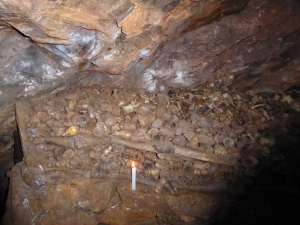I think I’ve mentioned I’ve joined a geology group; we meet once a month and visit a place of geological note and interest. I know very little about it all, but I’m learning, learning a lot! Actually looking at rocks and land forms rather than seeing pictures in books or reading descriptions brings it alive and makes sense. Today we visited a nearby village which is famous for a cave there containing a mass of animal bones, seventy odd thousand years old. I’ve visited before a couple of times, but each time is exciting all over again an each time new information has been discovered.
This is what I wrote on the previous trip:
The Mendip hills of Somerset are riddled with caves,potholes, underground streams and lakes… no-one actually knows the extent of the system or systems, but each in its own way is a marvel. Yesterday we were fortunate enough to visit a cave known as the Bone Cave in Banwell, a small village not far from us here where we live at the end of the Mendip chain in Uphill.
The minerals within the hills have been exploited for thousands of years, and in the Banwell area there are seams of yellow and red ochre, the yellow is a hydrated iron hydroxide known as limonite, the red is from iron… that’s about the extent of what I have learned about ochre! It was used as a dye and colouring agent going back to the earliest human activity when people decorated their caves and no doubt themselves with the colours.
The Bone Cave was called the Bone Cave because of the vast quantity of bones found in it when it was discovered in 1824; it was an accidental discovery because a nearby cave full of stalactites had been discovered fifty years before, and in an effort to open it as a tourist attraction to raise money for the village school, a tunnel was dug which broke into the Bone Cave.
The bones, a wondrous mixture of skeletal remains of wolves, wolverines, bison, reindeer, other deer, and a bear had arrived quite naturally, washed in nearly a hundred thousand years ago during the Ice Age. Many of them have been gathered and neatly stacked to form exhibits for the nineteenth century tourists; however, many thousand upon thousand remain beneath the floor of the cave. The Bishop of Bath and Wells, George Henry Law, had a residence built there and he believed that the bones were evidence of the Biblical flood which had engulfed the world.
 Lit by candles, it was magical!
Lit by candles, it was magical!
The original summerhouse of the Bishop was extended and rebuilt over the years and then went through some difficult times when it was neglected and bought by speculators, before being taken over and lovingly and beautifully restored by the present owners. There are extensive grounds and there has been an incredible amount of work undertaken to bring the Victorian features back to their original state of beauty, including grottoes, a tower, arbours and more.
We had a great visit, topped off by a cream tea with freshly made warm scones!
Here is a link:


Reminds me of that Randy Travis song [ Picking Up Bones ]
LikeLiked by 1 person
I don’t think I know that… I’ll have a look on YouTube!
LikeLike
Check out [ It’s Just a Matter of Time ] by him also. He has a fantastic vocal range but a tragic personal life.
LikeLiked by 1 person
Oh dear, poor Randy… yes I will!
LikeLike